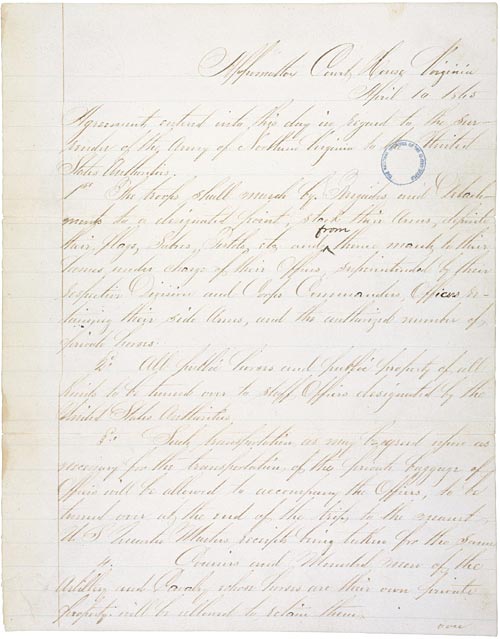
Articles of Agreement Relating to the Surrender of the Army of Northern Virginia (1865)
On April 9, 1865, Generals Ulysses S. Grant and Robert E. Lee met in the parlor of a house in Appomattox Court House, Virginia, to discuss the surrender of the Army of Northern Virginia, which would effectively end the Civil War.
After the fall of Richmond, the Confederate capital, on April 2, 1865, officials in the Confederate government, including President Jefferson Davis, fled. The dominoes began to fall. The surrender at Appomattox took place a week later on April 9th.
Generals Ulysses S. Grant and Robert E. Lee met in the parlor of a house in Appomattox Court House, Virginia, to discuss the surrender of the Army of Northern Virginia. The surrender formalities lasted four days. The terms were generous: the men of Lee's army could return home in safety if they pledged to end the fighting and deliver their arms to the Union Army.
On April 12, 1865, in a quiet but emotional ceremony, the infantry of Lee's army surrendered their arms, folded their battle flags, and received their parole papers, which guaranteed them safe passage home.
While it was the most significant surrender to take place during the Civil War, Gen. Robert E. Lee, the Confederacy's most respected commander, surrendered only his Army of Northern Virginia to Union Gen. Ulysses S. Grant. Several other Confederate forces – some large units, some small – had yet to surrender before President Andrew Johnson could declare that the Civil War was officially over.
The Grant-Lee agreement served not only as a signal that the South had lost the war but also as a model for the rest of the surrenders that followed. After Richmond fell and Davis fled, Confederate commanders were on their own to surrender their commands to Union forces. Surrenders, paroles, and amnesty for many Confederate combatants would take place over the next several months and into 1866 throughout the South and border states.
Not until 16 months after Appomattox, on August 20, 1866, did the President formally declare an end to the war.

